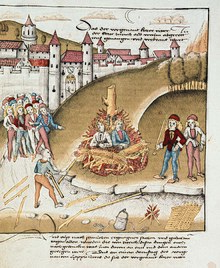
A | B | C | D | E | F | G | H | CH | I | J | K | L | M | N | O | P | Q | R | S | T | U | V | W | X | Y | Z | 0 | 1 | 2 | 3 | 4 | 5 | 6 | 7 | 8 | 9
| Part of a series on |
| Discrimination |
|---|
 |
| Part of a series on |
| LGBT topics |
|---|
|
|
Lesbian, gay, bisexual, transgender, queer, intersex, and asexual (LGBTQIA+) people frequently experience violence directed toward their sexuality, gender identity, or gender expression.[1][2] This violence may be enacted by the state, as in laws prescribing punishment for homosexual acts, or by individuals. It may be psychological or physical and motivated by biphobia, gayphobia, homophobia, lesbophobia, and transphobia. Influencing factors may be cultural, religious,[3][4][5] or political mores and biases.[6]
Currently, homosexual acts are legal in almost all Western countries, and in many of these countries violence against LGBT people is classified as a hate crime.[7] Outside the West, many countries are deemed potentially dangerous to their LGBT population due to both discriminatory legislation and threats of violence. These include countries where the dominant religion is Islam, most African countries (except South Africa), most Asian countries (except such LGBT-friendly countries as Israel, Japan, South Korea, Taiwan, Thailand, Vietnam and the Philippines), and some former communist countries such as Russia, Poland (LGBT-free zone), Serbia, Albania, Kosovo, Montenegro and Bosnia and Herzegovina.[5] Such violence is often associated with religious condemnation of homosexuality or conservative social attitudes that portray homosexuality as an illness or a character flaw.[3][4]
Historically, state-sanctioned persecution of homosexuals was mostly limited to male homosexuality, termed "sodomy". During the Middle Ages and the early modern period, the penalty for sodomy was usually death.[8] During the modern period (from the 19th century to the mid-20th century) in the Western world, the penalty was usually a fine or imprisonment. There was a drop in locations where homosexual acts remained illegal from 2009 when there were 80 countries worldwide (notably throughout the Middle East, Central Asia and in most of Africa, but also in some of the Caribbean and Oceania) with five carrying the death penalty[9] to 2016 when 72 countries criminalized consensual sexual acts between adults of the same sex.[10]
Brazil, a country with LGBT rights protections and legal same-sex marriage, is reported by Grupo Gay da Bahia (GGB) to have the world's highest LGBT murder rate, with more than 380 murders in 2017 alone, an increase of 30% compared to 2016.[11] Gay men experience potentially fatal violence in several places in the world, for example by ISIS or stoning by Nigeria, ISIS and others.[12][13][14]
In some countries, 85% of LGBT students experience homophobic and transphobic violence in school, and 45% of transgender students drop out of school.[15]
State-sanctioned violence
Historic

The Middle East
An early law against sexual intercourse between men is recorded in Leviticus by the Hebrew people, prescribing the death penalty. A violent law regarding homosexual intercourse is prescribed in the Middle Assyrian Law Codes (1075 BCE), stating: "If a man lay with his neighbor, when they have prosecuted him (and) convicted him, they shall lie with him (and) turn him into a eunuch".
In the account given in Tacitus' Germania, the death penalty was reserved for two kinds of capital offenses: military treason or desertion was punished by hanging, and so was moral infamy (cowardice and homosexuality: ignavos et imbelles at corpore infames); Gordon translates corpore infames as "unnatural prostitutes"; Tacitus refers to male homosexuality, see David F. Greenberg, The construction of homosexuality, p. 242 f. Scholarship compares the later Germanic concept of Old Norse argr, Langobardic arga, which combines the meanings "effeminate, cowardly, homosexual", see Jaan Puhvel, 'Who were the Hittite hurkilas pesnes?' in: A. Etter (eds.), O-o-pe-ro-si (FS Risch), Walter de Gruyter, 1986, p. 154.
Europe

Laws and codes prohibiting homosexual practice were in force in Europe from the fourth[16] to the twentieth centuries.
Roman Empire
In Republican Rome, the poorly attested Lex Scantinia penalized an adult male for committing a sex crime (stuprum) against an underage male citizen (ingenuus). It is unclear whether the penalty was death or a fine. The law may also have been used to prosecute adult male citizens who willingly took a receiving role in same-sex acts, but prosecutions are rarely recorded and the provisions of the law are vague; as John Boswell has noted, "if there was a law against homosexual relations, no one in Cicero's day knew anything about it."[17] When the Roman Empire came under Christian rule, all male homosexual activity was increasingly repressed, often on pain of death.[16] In 342 CE, the Christian emperors Constantius and Constans declared same-sex marriage to be illegal.[18] Shortly after, in the year 390 CE, emperors Valentinian II, Theodosius I and Arcadius declared homosexual sex to be illegal and those who were guilty of it were condemned to be publicly burned alive.[16] Emperor Justinian I (527–565 CE) made homosexuals a scapegoat for problems such as "famines, earthquakes, and pestilences."[19]
Switzerland
The earliest known execution for sodomy was recorded in the annals of the city of Basel in 1277. The mention is only one sentence: "King Rudolph burned Lord Haspisperch for the vice of sodomy." The executed was an obscure member of the German-Swiss aristocracy; it is unknown if there was a political motivation behind the execution.[20]
France and Florence
During the Middle Ages, the Kingdom of France and the City of Florence also instated the death penalty. In Florence, a young boy named Giovanni di Giovanni (1350–1365?) was castrated and burned between the thighs with a red-hot iron by court order under this law.[21][22] These punishments continued into the Renaissance, and spread to the Swiss canton of Zürich. Knight Richard von Hohenberg (died 1482) was burned at the stake together with his lover, his young squire, during this time. In France, French writer Jacques Chausson (1618–1661) was also burned alive for attempting to seduce the son of a nobleman.
England
In England, the Buggery Act 1533 made sodomy and bestiality punishable by death.[23] This act was superseded in 1828, but sodomy remained punishable by death under the new act until 1861, although the last executions were in 1835.[24]
Malta
In seventeenth century Malta, Scottish voyager and author William Lithgow, writing in his diary in March 1616, claims a Spanish soldier and a Maltese teenage boy were publicly burnt to ashes for confessing to have practiced sodomy together.[25][26] To escape this fate, Lithgow further claimed that a hundred bardassoes (boy prostitutes) sailed for Sicily the following day.[25]
The Holocaust
In Nazi Germany and Occupied Europe, homosexuals and gender-nonconforming people[27] were among the groups targeted by the Holocaust (See Persecution of homosexuals in Nazi Germany). In 1936, the poet Federico García Lorca was executed by right-wing rebels who established Franco's dictatorship in Spain.
Contemporary

| Same-sex intercourse illegal. Penalties: | |
Prison; death not enforced | |
Death under militias | Prison, with arrests or detention |
Prison, not enforced1 | |
| Same-sex intercourse legal. Recognition of unions: | |
Extraterritorial marriage2 | |
Limited foreign | Optional certification |
None | Restrictions of expression |
Restrictions of association with arrest or detention | |
1No imprisonment in the past three years or moratorium on law.
2Marriage not available locally. Some jurisdictions may perform other types of partnerships.
As of June 2023[update], 63 countries criminalize consensual sexual acts between adults of the same sex.[citation needed]
- Afghanistan
- Brunei
- Iran (fourth conviction)[28]
- Mauritania[28]
- North Korea
- Saudi Arabia
- Although the maximum punishment for homosexuality is execution, the government tends to use other punishments (fines, prison sentence, and whipping), unless government officials think that homosexuals have challenged state authority by engaging in LGBT social movements.[29]
- Somalia[10]
- Uganda
- United Arab Emirates
- Yemen[28]
- Parts of Nigeria (some states in Northern area)
53 countries where homosexual acts are criminalized but not punished by death, by region, include:[citation needed]
Africa
- Algeria, Burundi, Cameroon, Chad, Comoros, Egypt, Eritrea, Eswatini, Ethiopia, Gambia, Ghana, Guinea, Kenya, Liberia, Libya, Malawi, Morocco, Namibia, Nigeria (death penalty in some states), Senegal, Sierra Leone, South Sudan, Sudan,[30] Tanzania, Togo, Tunisia, Uganda, Zambia, Zimbabwe
Asia
- Bangladesh, Myanmar, Kuwait, Malaysia, Aceh (Indonesia), Maldives, Oman, Pakistan, Marawi City (Philippines), Sri Lanka, Syria, Turkmenistan, United Arab Emirates, Uzbekistan, Gaza Strip under Palestinian Authority
America
- Antigua and Barbuda, Barbados, Dominica, Grenada, Guyana, Jamaica, Saint Kitts and Nevis, Saint Lucia, Saint Vincent and the Grenadines
Pacific Islands
Afghanistan, where such acts remain punishable with fines and a prison sentence, dropped the death penalty after the fall of the Taliban in 2001, who had mandated it from 1996. India criminalized homosexuality until September 6, 2018, when the Supreme Court of India declared section 377 of the Indian Penal Code invalid and arbitrary when it concerns consensual relations of consenting adults in private.
Zdroj:https://en.wikipedia.org?pojem=Violence_against_LGBT_people
Text je dostupný za podmienok Creative Commons Attribution/Share-Alike License 3.0 Unported; prípadne za ďalších podmienok. Podrobnejšie informácie nájdete na stránke Podmienky použitia.
Antropológia
Aplikované vedy
Bibliometria
Dejiny vedy
Encyklopédie
Filozofia vedy
Forenzné vedy
Humanitné vedy
Knižničná veda
Kryogenika
Kryptológia
Kulturológia
Literárna veda
Medzidisciplinárne oblasti
Metódy kvantitatívnej analýzy
Metavedy
Metodika
Text je dostupný za podmienok Creative
Commons Attribution/Share-Alike License 3.0 Unported; prípadne za ďalších
podmienok.
Podrobnejšie informácie nájdete na stránke Podmienky
použitia.
www.astronomia.sk | www.biologia.sk | www.botanika.sk | www.dejiny.sk | www.economy.sk | www.elektrotechnika.sk | www.estetika.sk | www.farmakologia.sk | www.filozofia.sk | Fyzika | www.futurologia.sk | www.genetika.sk | www.chemia.sk | www.lingvistika.sk | www.politologia.sk | www.psychologia.sk | www.sexuologia.sk | www.sociologia.sk | www.veda.sk I www.zoologia.sk
